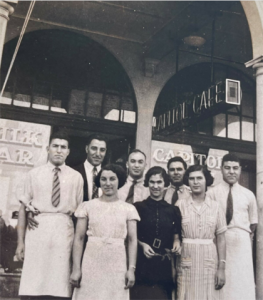The Greek-Australian migration story told in pictures
A fascinating new collection of photos gives insights into the lives of Greek migrants to Australia between 1900 and 1950.
The collection, compiled by La Trobe University, contains photographs depicting Greek migrants in Australia during the first half of the twentieth century. Subjects include labour, leisure, family life, and the arts.
 From the last decade of the 19th century until WWI the number of Greeks immigrating to Australia increased steadily and Greek communities became well established in Melbourne and Sydney.
From the last decade of the 19th century until WWI the number of Greeks immigrating to Australia increased steadily and Greek communities became well established in Melbourne and Sydney.
The first Greek language newspaper appeared and in 1913 published in Melbourne. During WWI Greece remained neutral, eventually joining the side of the Allies.
But In 1916 the Australian government placed a prohibition on the entry of Greeks and Maltese people to Australia that was not lifted until 1920.
There were a few anti-Greek protests because of Greece’s neutrality, often instigated by Australian soldiers on leave. The worst of the rioting occurring on Kalgoorlie/Boulder goldfields in WA with Greek cafes and shops damaged.
During the 1920s, as a result of the Greco-Turkish War there was a significant amount of Greek migration to Darwin and across the Top End. Greeks often worked in the cane fields in North Queensland and moved to Darwin during the dry season to work in the pearling industry.
The Paspaley family from the island of Kastellorizo, were pioneers of the Pearling industry and now have shops across Australia.
The first major flow of Greek immigrants to Australia began in the mid-1920s, when a large number of Greek people from the island of Kastellorizo migrated to Australia to escape repression by the Ottoman Empire.
Most of these people spent time in Alexandria, Egypt’s second largest city, before being offered migration to Australia by British authorities.
During the interwar period, the number of Greeks migrating to Australia increased substantially. Some were expelled from Asia Minor after the Greek military defeat while other Greeks sought entry after the USA established restrictive immigration quotas in the early 1920s.
Greece entered WWII on the Allied said after the country was invaded by German and Italian troops who remained in Greece until 1944
Australia soldiers were sent to Greece to try to defeat the Axis enemy only to be saved themselves by the locals, building a relationship between Australians and Greeks that stands strong to this day.
When the allied troops withdrew after the war, a struggle broke out between pro and anti-communist factions which resulted in bloody civil war between 1946 and 1949, which cost thousands of lives.
Devastated by years of war, the Greek government encouraged post-war migration as a way of solving poverty and unemployment problems.
In the late 1940s, 1950s, and 1960s, Greeks were one of the main European races picked by the Australian government’s ‘Populate or Perish’ immigration scheme. As a result, thousands of Greeks migrated to Australia to gain a better life and future for themselves and their families.
See the collection here: https://opal.latrobe.edu.au/collections/Greek-Australian_Migration_Story_photography_1900-1950/5544348












